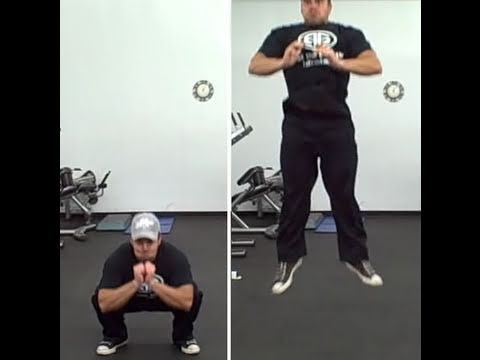Anyone who strength trains long enough will probably reach a plateau, even with progressive overload. This can be incredibly discouraging, but fortunately the cure can be as easy as just changing things up a bit in your workout. One way to do that is to start incorporating bodyweight jump squats into your training program.
I have a love/hate relationship with this exercise. I hate it because it’s hard, but I love it because it works; and works well. Hey, when it comes to strength training, it’s not meant to be easy!
Wake Up Your Nervous System
Bodyweight jump squats are a plyometric exercise. Unlike traditional strength training, (where the goal is just to move as much weight as you can regardless of speed) plyometrics focus on fast, explosive movements. Plyometrics are great addition to a strength training program because they will help you to increase your speed and power. Power basically being the ability to convert strength into speed. We can think of this in terms of a car, where power is the ability to accelerate quickly, and strength is the ability to keep up that speed.
You’ll want to be able to “accelerate” quickly.
This has a number applications in athletics, but if your goal is simply to put more weight on the barbell, this will be of benefit to you. Why? The explosive element of the exercise will help to increase muscle motor unit recruitment and the efficiency of your nervous system. In fact, you can use bodyweight jump squats in your warm-up to help fire up your nervous system before you start heavy lifting. You might be surprised to find the weight will feel lighter because your nervous system really comes “alive” when you do plyometrics.
Here’s an example of how you can incorporate bodyweight jump squats into your routine:
[youtube https://www.youtube.com/watch?v=gSAq-gZ3IZo]
I like his method of adding these at the end of the workout, and keeping the reps/sets low to focus on maximal effort. I will say though that after a heavy squat day, these are going to be absolutely brutal. I also like how he performs them using a full squat instead of a partial squat, which is what I see with a lot of people performing jump squats. For athletes who are performing jump squats with weight, the use of a partial squat is fine and, depending on how much weight, a lot safer. Since we are focusing on bodyweight jump squats, I find the full squat to be a more efficient movement. You’ll really have to fire your whole posterior chain to explode up out of the bottom.
A buddy of mine has been doing just bodyweight exercises for months and has put on a considerable amount of muscle in a short amount of time. The only thing he does for legs is bodyweight jump squats. He swears by them. I kinda think he’s nuts, but I can personally attest to how effective they are. The first thing I do when I start to reach a plateau or get bored with my training is to incorporate them into my workout. The way I implement them is sporadically, as I feel it keeps my body guessing.
Try ’em out for yourself if you dare!
In case you are trying to take your squat training to the next level, look into the Ultimate Guide to Bodyweight Squats and Pistols.

